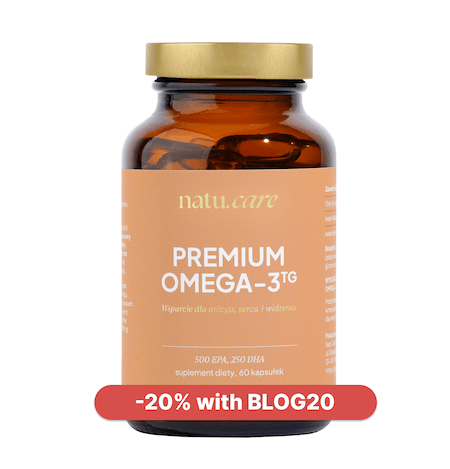Psoriasis of the skin, nails, joints: causes, symptoms and treatment
Key facts about psoriasis, its symptoms and treatments.


Learn more about our editorial process
.

Learn more about our editorial process
.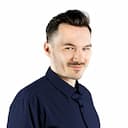

Learn more about our editorial process
.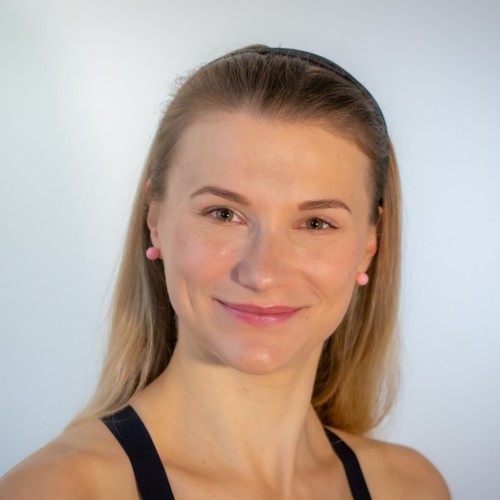

Learn more about our editorial process
.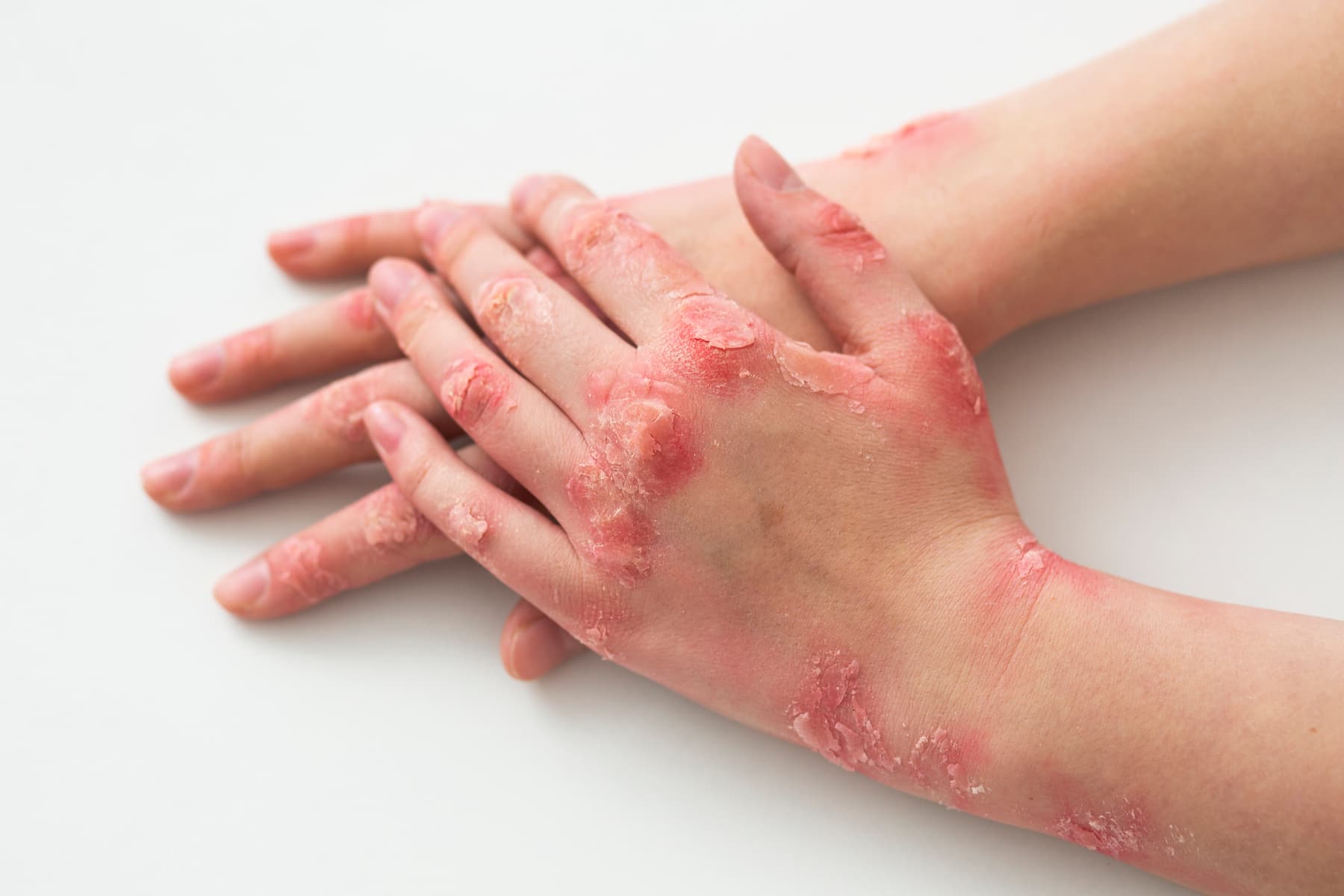
Why you can trust us
Articles on Natu.Care are written based on scientific research, data from government websites and other reliable sources. The texts are written in cooperation with doctors, nutritionists and other health and beauty experts. Articles are reviewed before publication and during significant updates.
.Learn more about our editorial process
.Information about advertisements
Content on Natu.Care may contain links to products from the sale of which we may receive a commission. When creating content, we adhere to high editorial standards and take care to be objective about the products discussed. The presence of affiliate links is not dictated by our partners, and we select the products we review ourselves completely independently.
.Learn more about our terms and Conditions
.It is not contagious and is not due to lack of hygiene. Despite this, people with psoriasis often suffer from social isolation.
Understanding this disease is an excellent tool to change this and improve the lives of those who struggle with it. Psoriasis has a genetic basis and is increasingly being referred to as a systemic condition rather than a dermatological one.
The disease is not just a dermatological condition.
From this article you will learn:
- What is psoriasis and what are its causes.
- What is psoriasis?
- In which forms this condition occurs. .
- What its symptoms are.
- What are the symptoms of psoriasis?
- What are the treatments for psoriasis. .
- What other skin diseases may produce similar symptoms.
- What are the treatments for psoriasis?

Sprawdź, za co pokochały go tysiące klientek Natu.Care Premium Omega-3ᵀᴳ -15% z kodem BLOG15
Natu.Care Omega-3ᵀᴳ Premium
Natu.Care Omega-3ᵀᴳ Premium dla zdrowia serca, mózgu i odporności. Najlepsza przyswajalność. Optymalna dawka 750 mg. Przebadana przez niezależne laboratorium.
Zobacz więcej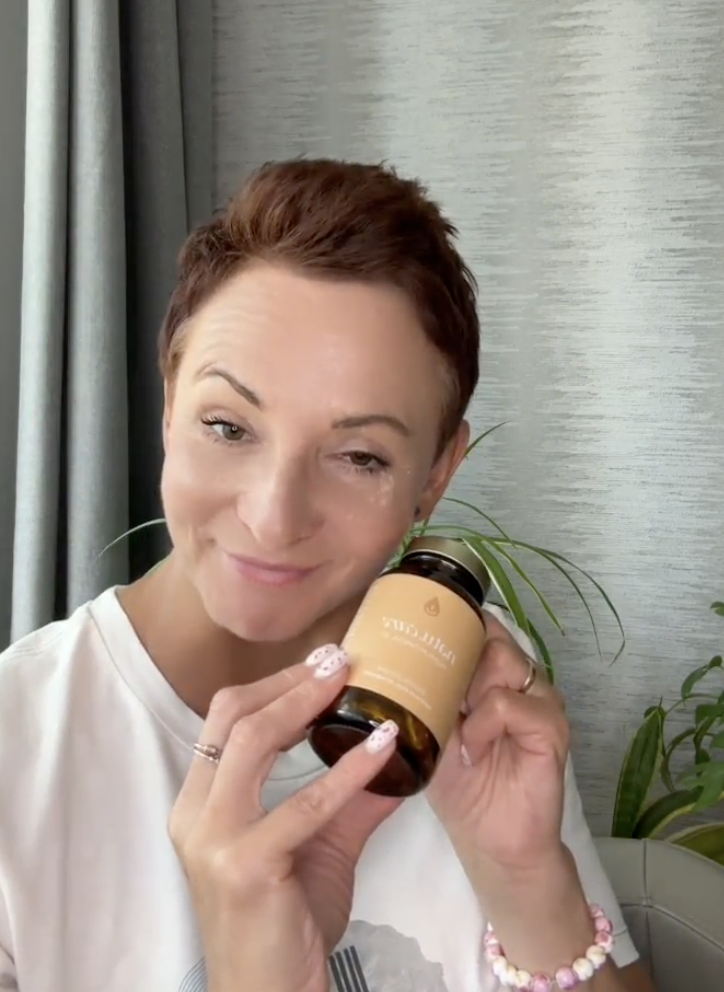
Produkt ma super skład, transparentną etykietę i co dla mnie jest ważne – małe kapsułki do połknięcia. Nie ma też nieprzyjemnego efektu odbijania rybą, który miałam spożywając inne produkty. Widzę znaczną poprawę odporności. Polecam!@Kasia P.
See also:
.What is psoriasis?
.Psoriasis (Latin) psoriasis) is an autoimmune, chronic disease of the skin, nails or joints with a genetic basis. It develops inflammation (usually a reddened area on the skin), under the influence of which keranocytes (keratin-producing cells in the skin) start to produce excessively. As they die off - the skin in the affected area begins to peeland.
.The disease is relapsing, meaning that periods of remission alternate with phases when psoriasis becomes active. When this occurs, its symptoms worsen and the nature of the skin lesions can transformand.
Based on the age of onset, there are two types of psoriasis. If the disease manifests before the age of 40, it is classified as type I. The peak incidence of this type is between 16 and 22 years of age. Type II attacks after the age of 40 - most commonly people in the 57-60 age rangeand.
It is estimated that psoriasis affects about 2% of people worldwide, but some populations are more or less susceptible to it. Asians suffer from it less frequently, while the prevalence in Scandinavians can be as high as 11%and.
Population of psoriasis in Poland
.It is estimated that psoriasis affects around 3% of the population in Poland. This means that more than one million people are affectedand.
Places on the body that are particularly prone to psoriatic lesions areand:
.- the scalp, .
- face, .
- hands, .
- soles of the feet, .
- armpits and groin,
- genital organs, and
- genital organs, .
- nails, .
It is worth mentioning that psoriasis is often accompanied by comorbidities, most commonly affecting the cardiovascular system and liver. In approximately 10-30% of cases, patients with skin psoriasis are also affected by psoriatic arthritis. Psoriasis patients are also often diagnosed with depression, which can result from the social ostracism that patients often have to deal withand.
I don't like people looking at me. Sometimes I feel like they're disgusted... Once I was in the playground with my daughter. A little boy started coming up to me, he wanted to give me a tractor. His mother rushed over, shouting: Don't! Don't come any closer! People can be cruel to people with psoriasis. They have minimal knowledge of the disease and look at it in terms of appearance, i.e. ugly skin means lack of hygiene..
Marek A psoriasis patient
Psoriatic erythroderma
.Psoriatic erythroderma is psoriasis at its most severe. Inflammation and dermatological lesions can involve up to 90% of the skin. Patients affected by erythroderma are also often accompanied by feverand.
When the skin is damaged over such a large area, it ceases to perform its protective functions. As a result, patients are susceptible to excessive water loss and even protein loss. They are also much more prone to invasion by bacteria and other pathogenic organisms, as well as impaired body temperature control.
Is psoriasis contagious?
.No, psoriasis is not a contagious disease. It cannot be contracted through any type of contact with the patient. The condition results from a malfunction of the immune system and most likely has a genetic basis. The heritability of psoriasis is estimated to be as high as 60-90%and.
Research shows that people with psoriasis have mutations in HLA antigens, which are an important factor when the immune system recognises its own tissues..
 .
.
Kacper Nihalani doctor
I was so stressed by the disease that after my daughter was born, I was afraid to touch her. Yet I know full well that psoriasis is not contagious..
Marek A psoriasis sufferer
Does psoriasis itch?
.Yes, psoriasis can be itchy. As a result of the excessive production of the stratum corneum, the stratum corneum dies and flakes off. This leads to water loss, violation of the hydrolipidic layer and dryness of the skin. All these processes can result in persistent itching, as well as a burning sensation and hypersensitivity of a particular area on the bodyand.
.Where does psoriasis come from - causes
.The main causes of psoriasis include a genetic predisposition. Other factors such asand:
may also increase the risk of developing the condition.- streptococcal infection, .
- stress, .
- cigarette smoking, .
- obesity, .
- alcohol consumption, .
The condition of psoriasis can also be aggravated by certain medications for hypertension and arrhythmia, ibuprofen, naproxen or ketonal. The seasons also affect the course of psoriasis. Usually summer is good for the skin condition, and it worsens in winter..
 .
.
Kacper Nihalani doctor
The causes of psoriatic lesions are errors in skin and epidermal cell differentiation and abnormalities in the innate and acquired cutaneous immune response, which is associated with inflammation. Both of these mechanisms overlap, mutually amplifying their adverse effects on the patientand.
Forms of psoriasis
.There are many forms of psoriasis and although they all have a similar mechanism, they can be triggered by changes in different genes .
Dermatitis
.Dermatitis is one of the most common skin diseases in the world. Although the changes are visible just on the skin, according to research they can affect the functioning of the entire body and internal organs. This is why psoriasis is increasingly being classified as a systemic disease rather than strictly dermatologicaland.
Pustular psoriasis
.Pustular psoriasis most commonly affects the hands and feet. It manifests as yellow pustules that appear on a patch of erythema. This type of psoriasis can also take a generalised form, in which case the erythema and pustules can attack the surface of the whole body. The patient gets a fever and often requires hospitalisationand.
Pustular psoriasis
.This form of psoriasis has many names: droplet, papular or fine-needle. All these terms describe skin lesions resembling reddened tiny infiltrates (quasi-dots) or papules. It often appears in children, but also affects adults. Its occurrence may be related to a streptococcal throat infectionand.
.Studies show that droplet psoriasis can also occur after COVID-19..
 .
.
Kacper Nihalani doctor
Plaque psoriasis
.Plaque psoriasis is also called ordinary, as it is the most common and can be said to be classic form of psoriasis. It is characterised by red patches surrounded by a lighter ring (called a Voronoff ring). A white layer of keratinised and scaly skin forms on the surface of the erythematous skin. This can resemble the appearance of fish scalesand.
The lesions in plaque psoriasis most commonly appear on the trunk, extremities (especially knees and elbows) and scalp. Less commonly, they affect the face, hands and feetand.
Inverted psoriasis
.Inverted psoriasis is also referred to as flexural psoriasis because the affected areas are usually the 'folds' of the body, such as the armpits, groin, junction of the buttocks and even the bends of the elbows . Another name for this type of psoriasis is exudative psoriasis.
The feature of this form of psoriasis is the absence of white scaly skin cells. The lesions are red and slightly shinyand.
.Nail psoriasis
.Nail psoriasis can occur together with or as the only symptom of skin psoriasis. It is estimated that around 80% of patients with skin psoriasis will also develop the nail formand.
If the disease attacks the nail matrix, the symptoms will be pitting and unevenness in the nail plate and the appearance of white spots or stripes on the nails (known as leukonychia) . If, on the other hand, it occupies the nail bed, it will lead to separation of the nail plate from the nail bed, excessive keratosis of the nails and a change in colour to yellow .
Nail psoriasis, due to its location, is one of the most difficult forms of this disease to treat .
Arthritic psoriasis
.Psoriatic arthritis (Psoriatic arthritis, psoriatic arthritis, Latin psoriatic arthritis) affects approximately 20% of patients with skin psoriasis. However, as studies have shown, the genes responsible for the occurrence of these two conditions do not completely overlapand.
In the majority of patients (68%), psoriatic skin lesions are the first to present, but occasionally psoriatic arthritis may be the first to present .
.The disease is characterised by chronic inflammation of the tendons, ligaments and joint capsules. The symptoms are very similar to rheumatoid arthritis (RA), so the diseases can be confused with each other - especially if Psoriasis occurs first, before skin psoriasisand.
The main distinguishing feature of psoriatic arthritis, however, is the absence of rheumatoid factor (RF), which is found in RA. An increase in its concentration in the body will be shown by appropriate blood tests. In addition, psoriatic arthritis often affects joints that do not have much synovial fluid - for example, the interphalangeal jointsand. Tendon attachments are also characteristically involved, which translates into pain in the heels, spine and where the ribs join the sternum .
The condition is usually mild and may affect one joint or more. It is also quite typical for the whole finger to be involved - both joints and tendons and soft tissues. The finger is then swollen, painful and clearly distinguishable from fingers not affected by the diseaseand.
The so-called 'sausage finger' ( sausage finger) symptom is useful for differentiating psoriatic arthritis from other forms of arthritis..
 .
.
Kacper Nihalani doctor
In severe psoriatic arthritis, joint surfaces and even parts of the bones can be destroyedand.
Along with psoriatic arthritis there are often other diseases that can either follow chronic inflammation going on in the body or present as one of the symptoms of psoriatic arthritis. Comorbidities includeand:
- gout gout, .
- conjunctivitis or uveitis, .
- atherosclerosis and other cardiovascular diseases, .
See also:
Bone psoriasis
.Bone psoriasis is actually the psoriatic arthritis described above, which has taken over the bone tissue in addition to the joint surfaces and led to its degradation. In addition, chronic inflammation, or an abnormal immune system response, also affects bone metabolism, which can lead to osteoporosisand.
Symptoms of psoriasis
.Psoriasis is most commonly manifested by red, blotchy lesions on the elbows, knees, scalp or other areas of the body. The surface of the red patches is covered by a layer of white, keratinised epidermis that peels off. In addition, yellowing and delamination of the nail plate may occur. Twenty per cent of patients also develop psoriatic arthritisand.
Initial symptoms of psoriasis
.The first symptoms of psoriasis are usually heavily reddened and slightly thickened patches on the skin that itch or hurt. A so-called primary lesion appears, which is a maroon lump whose top layer begins to be covered by silvery-white, scaly skinand. In addition, psoriasis can be helped to diagnose other specific symptoms described below.
Koebner's sign
.The Koebner (Köbner) symptom is that in the active phase of psoriasis, any trauma to the epidermis (e.g. a scratch, a minor cut) causes psoriatic lesions to form in the damaged area within a few days. This symptom does not occur during remission of the diseaseand. Interestingly, Koebner's symptom can also occur with other dermatoses (skin conditions).
Auspitz symptom
.Auspitz symptom is the occurrence of pinpoint bleeding after the patient scrapes off plaques of scaly skin. The blood appears due to the much shallower location of blood vessels in the areas of skin affected by psoriatic lesionsand.
Stearin candle symptom
.Stearin candle symptom occurs when fragments of keratinised epidermis are scraped off, but shallow enough to avoid bleeding. When this happens, underneath the white scales, you will see a shiny layer of skin that looks like it is covered in stearin (which is a waxy vegetable fat)and.
How to treat psoriasis?
.The form of treatment for psoriasis depends on the severity of its symptoms. For mild forms, topical treatment with glucocorticosteroids, derivatives vitamin D and phototherapy is often sufficient. More severe forms, with more extensive lesions or comorbidities, may require systemic treatmentand.
Lifestyle changes are also important in the treatment of psoriasis. For example, giving up smoking or losing excess weight..
 .
.
Kacper Nihalani doctor
A 2019 scientific paper reports several studies that suggest that in some cases of droplet and plaque psoriasis, a positive therapeutic effect may be given by excision of the tonsils. However, this is not a common practice, although 87% of people undergoing this procedure found it cost-effectiveand.
A review of 2017 studies instead focused on examining the effect of supplementation with omega-3 acids on the course of psoriasis. In some of the studies cited, they were given to participants as an adjunct to standard drug therapy. Most dealt with oral supplementation of omega-3 fatty acids, but in one they were given as intravenous infusions.
Although the results are inconclusive (several experiments failed to achieve clinically significant improvement), most studies suggest a positive effect of omega-3 fatty acids on the course of psoriasis, resulting in relief of pruritus and inflammation and a decrease in the surface area of skin lesionsand.
.Product description
The dietary supplement contains omega-3ᵀᴳ, or omega-3 acids in the form of trójglyceridesów. Scientific studies suggest that this form of fatty acidsós up to 2 times better absorbed than the estersós present in many dietary supplements on the market. This means that you are assured of their effectiveness and of supplying yourself with valuable omega acids.
Fatty acids omega-3 are derived from wild anchovy oil. It is a rich source of healthy fats that are essential for the health of the cardiovascular, immune and nervous systems, as well as the proper function of vision, joints muscles.
Scientific research suggests that wild anchovies are a good source of healthy fats.
Scientific research also suggests that an adequate intake of omega-3 fatty acidsós protects against and supports the treatment of depression and anxiety disorders. In addition, omega-3s influence the hydration and appearance of the skinóry and support healthy sleep.
.
The formula contains a total of 750 mg of EPA+DHA acidsós, which is three times higher than the recommended minimum of 250 mg for the Polish population. Omega-3 TG Premium has studies indicating that its TOTOX is 9, which is a very good result.
Supplementation of omega-3 fatty acidsóis recommended for anyone who does not eat 1–2 portions (approximately 300 g) of oily fish per week. Children during growth, seniors, physically active people, vegans and vegetarians, as well as patients undergoing cardiovascular treatment and prevention of heart disease also have an increased need.
Pros and cons
The dietary supplement contains omega-3ᵀᴳ, or omega-3 acids in the form of trójglyceridesów. Scientific studies suggest that this form of fatty acidsós up to 2 times better absorbed than the estersós present in many dietary supplements on the market. This means that you are assured of their effectiveness and of supplying yourself with valuable omega acids.
Fatty acids omega-3 are derived from wild anchovy oil. It is a rich source of healthy fats that are essential for the health of the cardiovascular, immune and nervous systems, as well as the proper function of vision, joints muscles.
Scientific research suggests that wild anchovies are a good source of healthy fats.
Scientific research also suggests that an adequate intake of omega-3 fatty acidsós protects against and supports the treatment of depression and anxiety disorders. In addition, omega-3s influence the hydration and appearance of the skinóry and support healthy sleep.
.
The formula contains a total of 750 mg of EPA+DHA acidsós, which is three times higher than the recommended minimum of 250 mg for the Polish population. Omega-3 TG Premium has studies indicating that its TOTOX is 9, which is a very good result.
Supplementation of omega-3 fatty acidsóis recommended for anyone who does not eat 1–2 portions (approximately 300 g) of oily fish per week. Children during growth, seniors, physically active people, vegans and vegetarians, as well as patients undergoing cardiovascular treatment and prevention of heart disease also have an increased need.
Additional information
The dietary supplement contains omega-3ᵀᴳ, or omega-3 acids in the form of trójglyceridesów. Scientific studies suggest that this form of fatty acidsós up to 2 times better absorbed than the estersós present in many dietary supplements on the market. This means that you are assured of their effectiveness and of supplying yourself with valuable omega acids.
Fatty acids omega-3 are derived from wild anchovy oil. It is a rich source of healthy fats that are essential for the health of the cardiovascular, immune and nervous systems, as well as the proper function of vision, joints muscles.
Scientific research suggests that wild anchovies are a good source of healthy fats.
Scientific research also suggests that an adequate intake of omega-3 fatty acidsós protects against and supports the treatment of depression and anxiety disorders. In addition, omega-3s influence the hydration and appearance of the skinóry and support healthy sleep.
.
The formula contains a total of 750 mg of EPA+DHA acidsós, which is three times higher than the recommended minimum of 250 mg for the Polish population. Omega-3 TG Premium has studies indicating that its TOTOX is 9, which is a very good result.
Supplementation of omega-3 fatty acidsóis recommended for anyone who does not eat 1–2 portions (approximately 300 g) of oily fish per week. Children during growth, seniors, physically active people, vegans and vegetarians, as well as patients undergoing cardiovascular treatment and prevention of heart disease also have an increased need.
Expert opinion
The dietary supplement contains omega-3ᵀᴳ, or omega-3 acids in the form of trójglyceridesów. Scientific studies suggest that this form of fatty acidsós up to 2 times better absorbed than the estersós present in many dietary supplements on the market. This means that you are assured of their effectiveness and of supplying yourself with valuable omega acids.
Fatty acids omega-3 are derived from wild anchovy oil. It is a rich source of healthy fats that are essential for the health of the cardiovascular, immune and nervous systems, as well as the proper function of vision, joints muscles.
Scientific research suggests that wild anchovies are a good source of healthy fats.
Scientific research also suggests that an adequate intake of omega-3 fatty acidsós protects against and supports the treatment of depression and anxiety disorders. In addition, omega-3s influence the hydration and appearance of the skinóry and support healthy sleep.
.
The formula contains a total of 750 mg of EPA+DHA acidsós, which is three times higher than the recommended minimum of 250 mg for the Polish population. Omega-3 TG Premium has studies indicating that its TOTOX is 9, which is a very good result.
Supplementation of omega-3 fatty acidsóis recommended for anyone who does not eat 1–2 portions (approximately 300 g) of oily fish per week. Children during growth, seniors, physically active people, vegans and vegetarians, as well as patients undergoing cardiovascular treatment and prevention of heart disease also have an increased need.
Product description
The dietary supplement contains high-quality fatty acids omega-3 from anchovy oil. It is a naturally rich source of healthy fats that are essential for cardiovascular, immune and nervous system health, as well as proper function of eyesight, joints muscles.
Scientific research also suggests that an adequate intake of omega-3 fatty acidsós protects against and supports the treatment of depression and anxiety disorders. In addition, omega-3s influence the hydration and appearance of the skinóry and support healthy sleep.
.
The dietary supplement contains 550 mg EPA+DHA per daily serving. This is more than double the official recommendations for the Polish population, whichóre suggesting an intake of at least 250 mg per day.
Supplementation of EPA+DHA is a good way to support healthy sleep.
Supplementation with omega-3 fatty acidsós is advisable if you do not consume 1–2 portions (approx. 300 g) of oily fish per week. There is also an increased need for physically active people, vegans and vegetarians, seniors, children during growth spurts and patients undergoing cardiovascular treatment and prevention of heart disease.
Pros and cons
The dietary supplement contains high-quality fatty acids omega-3 from anchovy oil. It is a naturally rich source of healthy fats that are essential for cardiovascular, immune and nervous system health, as well as proper function of eyesight, joints muscles.
Scientific research also suggests that an adequate intake of omega-3 fatty acidsós protects against and supports the treatment of depression and anxiety disorders. In addition, omega-3s influence the hydration and appearance of the skinóry and support healthy sleep.
.
The dietary supplement contains 550 mg EPA+DHA per daily serving. This is more than double the official recommendations for the Polish population, whichóre suggesting an intake of at least 250 mg per day.
Supplementation of EPA+DHA is a good way to support healthy sleep.
Supplementation with omega-3 fatty acidsós is advisable if you do not consume 1–2 portions (approx. 300 g) of oily fish per week. There is also an increased need for physically active people, vegans and vegetarians, seniors, children during growth spurts and patients undergoing cardiovascular treatment and prevention of heart disease.
Additional information
The dietary supplement contains high-quality fatty acids omega-3 from anchovy oil. It is a naturally rich source of healthy fats that are essential for cardiovascular, immune and nervous system health, as well as proper function of eyesight, joints muscles.
Scientific research also suggests that an adequate intake of omega-3 fatty acidsós protects against and supports the treatment of depression and anxiety disorders. In addition, omega-3s influence the hydration and appearance of the skinóry and support healthy sleep.
.
The dietary supplement contains 550 mg EPA+DHA per daily serving. This is more than double the official recommendations for the Polish population, whichóre suggesting an intake of at least 250 mg per day.
Supplementation of EPA+DHA is a good way to support healthy sleep.
Supplementation with omega-3 fatty acidsós is advisable if you do not consume 1–2 portions (approx. 300 g) of oily fish per week. There is also an increased need for physically active people, vegans and vegetarians, seniors, children during growth spurts and patients undergoing cardiovascular treatment and prevention of heart disease.
Expert opinion
The dietary supplement contains high-quality fatty acids omega-3 from anchovy oil. It is a naturally rich source of healthy fats that are essential for cardiovascular, immune and nervous system health, as well as proper function of eyesight, joints muscles.
Scientific research also suggests that an adequate intake of omega-3 fatty acidsós protects against and supports the treatment of depression and anxiety disorders. In addition, omega-3s influence the hydration and appearance of the skinóry and support healthy sleep.
.
The dietary supplement contains 550 mg EPA+DHA per daily serving. This is more than double the official recommendations for the Polish population, whichóre suggesting an intake of at least 250 mg per day.
Supplementation of EPA+DHA is a good way to support healthy sleep.
Supplementation with omega-3 fatty acidsós is advisable if you do not consume 1–2 portions (approx. 300 g) of oily fish per week. There is also an increased need for physically active people, vegans and vegetarians, seniors, children during growth spurts and patients undergoing cardiovascular treatment and prevention of heart disease.
ALLNUTRITION Omega 3 Strong
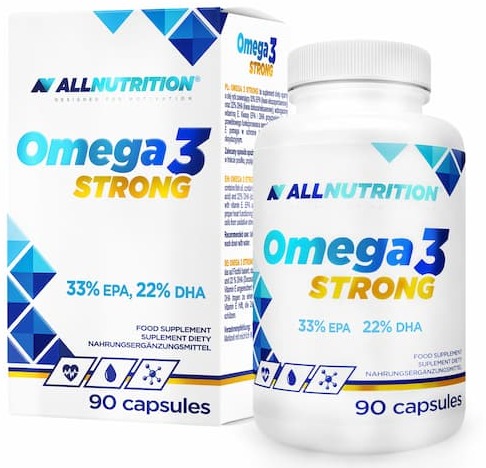
- Content omega-3 acids: 550 mg (DHA 220 mg + EPA 330 mg)
- Additional active ingredients: vitamin E
- Form: capsules .
- Dose: 1 capsule per day .
- Sufficient for: 90 days .
Product description
A dietary supplement with a solid portion of DHA and EPA – valuable for health and well-being omega-3 acidsós. Indicated especially for people on a plant-based diet, physically active people and seniors.
.The sourceóof omega-3 acids in this preparation is fish oil.
.Pros and cons
A dietary supplement with a solid portion of DHA and EPA – valuable for health and well-being omega-3 acidsós. Indicated especially for people on a plant-based diet, physically active people and seniors.
.The sourceóof omega-3 acids in this preparation is fish oil.
.Additional information
A dietary supplement with a solid portion of DHA and EPA – valuable for health and well-being omega-3 acidsós. Indicated especially for people on a plant-based diet, physically active people and seniors.
.The sourceóof omega-3 acids in this preparation is fish oil.
.User review
A dietary supplement with a solid portion of DHA and EPA – valuable for health and well-being omega-3 acidsós. Indicated especially for people on a plant-based diet, physically active people and seniors.
.The sourceóof omega-3 acids in this preparation is fish oil.
.Solgar Omega 3-6-9
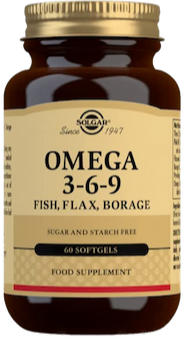
- Content of omega acids:.
- Omega-3 fatty acids.
- Omega-3 fatty acids
- alpha-linolenic acid (ALA) – 585 mg
.- eicosapentaenoic acid (EPA) – 344 mg
- docosahexaenoic acid (DHA) – 221 mg
.
- Omega-3 fatty acids
- Omega-6 fatty acids.
- linoleic acid (LA) – 598 mg .
- gamma-linolenic acid (GLA) – 274 mg .
- Omega-9 fatty acids.
- Oleic acid – 325 mg .
- Omega-3 fatty acids.
- Source of omega acids: fish oil from anchovies, mackerel, sardines, linseed oil, cucumber oil .
- Form: capsules .
- Packaging: 60 capsules .
- Daily allowance:3 capsules per day .
- Sufficient for: 20 days .
Product description
A combination of omega 3-6-9 fatty acidsós derived from fish and plants. The dietary supplement supplements essential omega fatty acids, whichóre needed for the proper functioning of many systemsóorgansóin the body.
Pros and cons
A combination of omega 3-6-9 fatty acidsós derived from fish and plants. The dietary supplement supplements essential omega fatty acids, whichóre needed for the proper functioning of many systemsóorgansóin the body.
Additional information
A combination of omega 3-6-9 fatty acidsós derived from fish and plants. The dietary supplement supplements essential omega fatty acids, whichóre needed for the proper functioning of many systemsóorgansóin the body.
A combination of omega 3-6-9 fatty acidsós derived from fish and plants. The dietary supplement supplements essential omega fatty acids, whichóre needed for the proper functioning of many systemsóorgansóin the body.
Omega + Vitamin D3 800 IU for children

- Content of omega-3 fatty acids: 300 mg (180 mg EPA + 120 mg DHA)
- .
- Additional active ingredients: vitamin D3
- Form: twist-off capsules
- .
- Dose: 1 capsule per day
- .
- Sufficient for: 60 days
- .
Product description
Omega-3 acids for children with added vitamin D3 in good doses. The formula fills the daily requirement of EPA and DHA and vitamin D for children aged 2–18 years.
The Ministry of Health recommends supplementation with vitamin D3. In turn, omega-3 fatty acids are also crucial for the youngest.
The dietary supplement from Aura Herbals supports mós brain function, proper vision and immune system function.
The omega-3 fatty acids are derived from fish oil sourced from anchovies.
Pros and cons
Omega-3 acids for children with added vitamin D3 in good doses. The formula fills the daily requirement of EPA and DHA and vitamin D for children aged 2–18 years.
The Ministry of Health recommends supplementation with vitamin D3. In turn, omega-3 fatty acids are also crucial for the youngest.
The dietary supplement from Aura Herbals supports mós brain function, proper vision and immune system function.
The omega-3 fatty acids are derived from fish oil sourced from anchovies.
Additional information
Omega-3 acids for children with added vitamin D3 in good doses. The formula fills the daily requirement of EPA and DHA and vitamin D for children aged 2–18 years.
The Ministry of Health recommends supplementation with vitamin D3. In turn, omega-3 fatty acids are also crucial for the youngest.
The dietary supplement from Aura Herbals supports mós brain function, proper vision and immune system function.
The omega-3 fatty acids are derived from fish oil sourced from anchovies.
User review
Omega-3 acids for children with added vitamin D3 in good doses. The formula fills the daily requirement of EPA and DHA and vitamin D for children aged 2–18 years.
The Ministry of Health recommends supplementation with vitamin D3. In turn, omega-3 fatty acids are also crucial for the youngest.
The dietary supplement from Aura Herbals supports mós brain function, proper vision and immune system function.
The omega-3 fatty acids are derived from fish oil sourced from anchovies.
{ product:2BE0AiQbPyKm9PugfT74OV }}
In psoriasis it's invaluable as you have support and know that someone accepts you..
Marek A psoriasis sufferer
Medicines for psoriasis
.First-line drugs are topical preparations containing corticosteroids and vitamin D analogues. Preparations that remove dead skin are also important. These are often supplemented with ointments and creams that form an occlusive layer on the skin - to further protect the sensitive areaand.
.For this purpose, the most common applications are:
.- keratolytic substances (e.g. urea or salicylic acid), which are supposed to reduce the amount of flaky skin; .
- glycocorticosteroids with anti-inflammatory properties, which are also able to locally influence the body's immune response; .
- Vitamin D derivatives (e.g. calcipotriol), which show similar effects to corticosteroids but have fewer side effects.
A topical drug that can be used to treat psoriasis is also cygnoline (also known as ditranol or anthralin). The substance has strong exfoliating properties, so it is applied to the skin for a few minutes and washed off. In addition, it has antibacterial and fungicidal effects and can promote epidermal regenerationand.
When it comes to systemic oral drugs, the most commonly used in psoriasis are acytretin (one of the retinoids) and methotrexate. In cases of severe psoriasis, also used cyclosporin Aand.
The absorption of cyclosporine is greatly reduced by grapefruit and grapefruit juice, so it is advisable for patients to ensure that they maintain a minimum 4-hour interval between taking the drug and grapefruit or grapefruit juice..
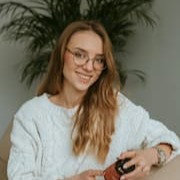 .
.
Julia SkrajdaDietitian
.Biological treatment of psoriasis
.Biological treatment involves the subcutaneous or intravenous administration of antibodies and soluble receptors that block pro-inflammatory cytokines. They therefore act on the underlying mechanisms of inflammationand.
Biologic treatment has very good results, especially in moderate-to-severe psoriasis .
.Biological treatment is usually only used in very severe cases. Monoclonal antibodies and interleukin inhibitors are used - interleukins are immune system signallers. The new drugs also cause inhibition of tyrosine kinase, an enzyme that plays a key role in cell proliferation..
 .
.
Kacper Nihalani doctor
Phototherapy for psoriasis
.Another treatment with good results is phototherapy. It uses narrow-band ultraviolet B (NB-UVB) radiation, which is safer for patients than UVA radiation. Phototherapy relieves inflammation within the irradiated lesions and accelerates the healing processand.
Diet in psoriasis
.Diet can affect both the severity and frequency of symptoms and help stabilise the disease. Some foods can promote inflammation in the body, so people with psoriasis should be wary of them. Others have the opposite effect and are part of an anti-inflammatory diet.
For psoriasis, antioxidants and omega unsaturated fatty acids - in the correct proportion - are the basis. An anti-inflammatory diet should be the base of the menu for a patient with psoriasis..
 .
.
Julia SkrajdaDietitian
.Products that psoriasis patients should avoid are:
.- .
- Alcohol: Regular consumption of alcohol can lead to an increase in psoriasis symptoms. In addition, alcoholic beverages can also adversely affect the effectiveness of medications used.
- Red meat and dairy products: These are high in saturated fatty acids, which can increase inflammation in the body and thus exacerbate psoriasis symptoms.
- Sugar: Excessive consumption of sugar (including sweets and fruit with a high glycaemic index) can lead to obesity, which is one of the risk factors for psoriasis. In addition, sugar can increase inflammation in the body. .
- Salt: High salt intake can also contribute to the severity of psoriasis symptoms. It's worth remembering that as well as the one you add to cooked food, you also eat large amounts of it in salty snacks and fast food.
Many scientific studies suggest that two dietary models work best for people with psoriasis: the Mediterranean diet and the vegetarian diet. Both help to significantly reduce inflammation in the body. Especially the vegetarian diet - properly balanced with additional supplementation of omega-3 fatty acids (EPA + DHA)..
 .
.
Julia SkrajdaDietitian
.On the other hand, there are many foods that can help relieve psoriasis symptoms. Here are some of them:
- .
- Fish and seafood: They are rich in omega-3 acids, which have proven anti-inflammatory effects.
- Vegetables and fruits: They are a source of antioxidants and fibre, which can help reduce inflammation. Of fruits, choose those with a low glycaemic index: berries, blueberries, currants or cherries. Avoid citrus, however. .
- Whole-grain products: They can help maintain a healthy body weight and reduce the risk of psoriasis symptoms.
- Seeds and nuts: Are rich in healthy fats and can help reduce inflammation.
Among the antioxidants in the diet for psoriasis, selenium is very important - it is worth placing great emphasis on the presence of foods high in selenium in the diet.
 .
.
Julia SkrajdaDietitian
.coffee and psoriasis
.It has been established that psoriasis sufferers should not drink coffee as it can exacerbate symptoms - this is argued by numerous articles on popular websites and even by some doctors. However, if you look at the websites of psoriasis associations and treatment centres, the opinions are no longer so clear-cut.
A 2018 study compared the severity of psoriasis symptoms in 221 patients who had not previously received treatment. It found that those consuming up to three cups of coffee a day had less severe skin lesions than patients who did not drink coffee. In contrast, those who consumed four or more cups of coffee showed significantly more severe lesionsand.
The results suggest that it is all about dose. It appears that coffee consumed in moderation should not worsen the course of the disease. However, if you are concerned about drinking this beverage, put it down or reduce your intake and watch to see if it affects your skin condition.
Bananas and psoriasis
.Bananas can be a healthy addition to the diet of psoriasis sufferers, but they should not be over-consumed as they contain a lot of sugar. Despite this, they are a fruit rich in various nutrients that can benefit skin health.
Bananas are an excellent source of vitamins such as vitamin C and B6, which are essential for skin health. Vitamin C is a powerful antioxidant that helps protect the skin from free radical damage. In turn vitamin B6 is crucial for the production of new skin cells, which can be particularly beneficial for people with psoriasis.
Bananas also contain a high amount magnesium and potassium. These minerals help to regulate inflammatory processes in the body, which can help to alleviate psoriasis symptoms.
Psoriasis or... something else?
.Any unusual skin lesion should prompt you to visit a dermatologist. Only a doctor will be able to make a correct diagnosis - don't try to do it on your own. However, waiting for an appointment and prolonged uncertainty can be stressful, so here's how to tell the difference between psoriasis and other skin conditions (if this is even possible at home).
Psoriasis vs tinea pedis
.It is worth noting at the outset that scalp ringworm is relatively rare. In addition, fungal lesions are different in appearance from psoriatic lesions. You already know that psoriasis is most often characterised by red, clearly demarcated lesions with a whitish, scaly surface.
With psoriasis, the centre of the lesion is usually healed, while the periphery of the lesion is the most flamed >. It forms a reddened ring of papulesand.
Dandruff versus dandruff
.Although with dandruff the scalp is also itchy and flaky, the main difference is the lack of inflammation that is characteristic of psoriasis. Dandruff sufferers, therefore, do not have erythema or reddened patches on the scalp.
Psoriasis versus eczema
.Till now it has been relatively straightforward, but this is where things start to get complicated. To begin with, it is worth clarifying that eczema is not actually a disease, but a syndrome of skin symptoms that accompanies various dermatological conditions.
Eczema is not a disease.
It can include redness, dryness of the skin, itching, pimples and much more. In most cases, you may not be able to tell the difference between them and the different types of psoriasis.
These are the most common types of psoriasis.
Psoriasis patches have clear borders and the upper skin tissue is thickened. Eczema appears more often in areas above the flexors, e.g. the elbow pit. Psoriasis - vice versa, in areas over the extensors..
 .
.
Kacper Nihalani doctor
Psoriasis versus seborrhoeic dermatitis
.The skin lesions in seborrhoeic dermatitis are erythematous (and therefore red) and have a layer of scaly skin on the surface. Sound familiar? Well it does. Although psoriatic areas are said to be drier, thickened and more distinct from healthy skin - let's not kid ourselves - you probably won't be able to recognise which ailment you're dealing with.
Psoriasis versus atopic dermatitis
.The skin lesions in atopic dermatitis (AD) can be distinguishable from psoriasis because of where they occur. Psoriasis often affects the tops of the elbows and knees, whereas AD typically occurs in the bends of the elbows.
Unfortunately, this is just quite a generalisation, as both one disease and the other can affect completely different areas of the body.
Important
Even specialists sometimes find it difficult to distinguish between different types of skin conditions. Therefore, don't play around with diagnosing with doctor Googling and go to a dermatologist. Only a doctor has the methods and tests that will give you confidence in the diagnosis and effective treatment.

Sprawdź, za co pokochały go tysiące klientek Natu.Care Premium Omega-3ᵀᴳ -15% z kodem BLOG15
Natu.Care Omega-3ᵀᴳ Premium
Natu.Care Omega-3ᵀᴳ Premium dla zdrowia serca, mózgu i odporności. Najlepsza przyswajalność. Optymalna dawka 750 mg. Przebadana przez niezależne laboratorium.
Zobacz więcej
Produkt ma super skład, transparentną etykietę i co dla mnie jest ważne – małe kapsułki do połknięcia. Nie ma też nieprzyjemnego efektu odbijania rybą, który miałam spożywając inne produkty. Widzę znaczną poprawę odporności. Polecam!@Kasia P.
Summary
.- Psoriasis is a chronic, relapsing and inflammatory autoimmune skin disease.
- Psoriasis is a chronic, relapsing and inflammatory autoimmune skin disease.
- It can come in many forms and affect different areas of the body, as well as the nails. The most common form is plaque psoriasis, which is characterised by red patches with a white, scaly layer of keratinised epidermis.
- Psoriasis is not a contagious disease, but can be hereditary. .
- In some patients, psoriasis can also attack the joints, tendons and ligaments and, in extreme cases, lead to degradation of bone tissue.
- Characteristic symptoms can help in the diagnosis of psoriasis: Koebner's, Auspitz's or stearic candle.
- Treatment of psoriasis can also be helpful.
- The treatment of psoriasis is a long-term process aimed at quieting the symptoms and bringing the disease into remission. Topical agents, systemic medications, phototherapy and biological treatments are used for this purpose. .
- The symptoms of psoriasis can easily be confused with skin lesions present in other dermatoses, so it is always important to see a doctor for a diagnosis. .
FAQ
.Is psoriasis hereditary?
.The causes of psoriasis are mainly on the genetic side, which is why psoriasis can be hereditary. According to studies, psoriasis is inherited in as many as 60-90% of cases. If you are in this risk group, avoid factors that promote the activation of the disease, such as long-term stress or stimulants. Also take care of your body weight with a balanced and healthy diet.
Can psoriasis be cured?
.Today there is no drug that can remove the cause of psoriasis, i.e. defects in the genome. Treatment of psoriasis is therefore based on fighting inflammation, alleviating skin lesions and putting the disease into remission so that the patient can function normally. Appropriately selected therapy, including topical agents, oral medication, phototherapy or biological treatment, yields good results and helps to significantly increase the patients' quality of life.
Is psoriasis contagious?
.No. Psoriasis is not a contagious disease. You cannot contract it from a sick person either through touch or through the droplet route. Psoriasis is an autoimmune disease, and its causes lie mainly in genes.
How to get rid of psoriasis?
.To get rid of the symptoms of psoriasis, you need to see a doctor. Only a specialist will be able to prescribe you appropriate pharmacotherapy or other methods to combat the condition. Psoriasis is a serious condition that is increasingly being treated as systemic, so never try to treat it with home remedies and on your own.
What does psoriasis on the face look like?
.Psoriasis on the face usually appears in the T-zone, that is, on the forehead, around the nose and on the chin. Sometimes it also attacks the eyelids. The skin shows red, slightly convex patches with scaly skin on the surface. Depending on the type of psoriasis, pustules and papules may also appear.
How does psoriasis start?
.Psoriasis begins with the appearance of red, rough patches on the skin, which very quickly become covered with a layer of flaky skin that resembles silvery scales. They are often painful and itchy. They most commonly appear on the elbows, knees, scalp, lower back, face, hands and feet.
What is the treatment for psoriasis?
.In most cases of psoriasis, the course of the disease is mild and topical preparations are sufficient for effective treatment. Corticosteroids and derivatives vitamin D are most commonly used. In more severe cases, drugs taken orally - such as retinoids or methotrexate - may be used. Phototherapy and biological treatments also have good results.
.How do you diagnose psoriasis?
.Psoriasis usually manifests as red, slightly convex patches covered with silvery scales of epidermis. It usually occurs on the elbows, knees, scalp and lower back. It is often accompanied by itching, pain or a burning sensation.
Psoriasis can also attack the nails. You may then notice changes such as grooves, depressions, thickening and delamination of the nail plate or a change in its colour to white or yellow. Psoriasis can also cause inflammation of the joints, leading to pain and swelling.
To find out if you have psoriasis, it is essential to see a dermatologist - only a doctor will be able to make a proper diagnosis and implement effective treatment.
Resources
.See all
.Al Aboud, A. M., & Crane, J. S. (2023). Tinea Capitis. In StatPearls. StatPearls Publishing. http://www.ncbi.nlm.nih.gov/books/NBK536909/
Armstrong, A. W., & Read, C. (2020). Pathophysiology, Clinical Presentation, and Treatment of Psoriasis: A Review. JAMA, 323(19), 1945-1960. https://doi.org/10.1001/jama.2020.4006
Barrea, L., Muscogiuri, G., Di Somma, C., Annunziata, G., Megna, M., Falco, A., Balato, A., Colao, A., & Savastano, S. (2018). Coffee consumption, metabolic syndrome and clinical severity of psoriasis: Good or bad stuff? Archives of Toxicology, 92(5), 1831-1845. https://doi.org/10.1007/s00204-018-2193-0
Boehncke, W.-H., & Schön, M. P. (2015). Psoriasis. The Lancet, 386(9997), 983–994. https://doi.org/10.1016/S0140-6736(14)61909-7
Elkhawaga, O. Y., Ellety, M. M., Mofty, S. O., Ghanem, M. S., & Mohamed, A. O. (2023). Review of natural compounds for potential psoriasis treatment. Inflammopharmacology, 31(3), 1183-1198. https://doi.org/10.1007/s10787-023-01178-0
Griffiths, C. E. M., Armstrong, A. W., Gudjonsson, J. E., & Barker, J. N. W. N. (2021). Psoriasis. The Lancet, 397(10281), 1301–1315. https://doi.org/10.1016/S0140-6736(20)32549-6
Hadeler, E., Mosca, M., Hong, J., Brownstone, N., Bhutani, T., & Liao, W. (2021). Nail Psoriasis: A Review of Effective Therapies and Recommendations for Management. Dermatology and Therapy, 11(3), 799-831. https://doi.org/10.1007/s13555-021-00523-x
Kamiya, K., Kishimoto, M., Sugai, J., Komine, M., & Ohtsuki, M. (2019). Risk Factors for the Development of Psoriasis. International Journal of Molecular Sciences, 20(18), Article 18. https://doi.org/10.3390/ijms20184347
Langley, R. G. B., Krueger, G. G., & Griffiths, C. E. M. (2005). Psoriasis: Epidemiology, clinical features, and quality of life. Annals of the Rheumatic Diseases, 64(suppl 2), ii18-ii23. https://doi.org/10.1136/ard.2004.033217
Mari, N. L., Simão, A. N. C., & Dichi, I. (2017). n-3 polyunsaturated fatty acid supplementation in psoriasis: A review. Nutrire, 42(1), 5. https://doi.org/10.1186/s41110-016-0029-3
Márquez-Balbás, G., Sánchez-Regaña, M., & Millet, P. U. (2011). Study on the use of omega-3 fatty acids as a therapeutic supplement in treatment of psoriasis. Clinical, Cosmetic and Investigational Dermatology, 4, 73-77. https://doi.org/10.2147/CCID.S17220
Raharja, A., Mahil, S. K., & Barker, J. N. (2021). Psoriasis: A brief overview. Clinical Medicine, 21(3), 170-173. https://doi.org/10.7861/clinmed.2021-0257
Rendon, A., & Schäkel, K. (2019). Psoriasis Pathogenesis and Treatment. International Journal of Molecular Sciences, 20(6), Article 6. https://doi.org/10.3390/ijms20061475
Saalbach, A., & Kunz, M. (2022). Impact of Chronic Inflammation in Psoriasis on Bone Metabolism. Frontiers in Immunology, 13. https://www.frontiersin.org/articles/10.3389/fimmu.2022.925503
Sankowski, A. J., Lebkowska, U. M., Ćwikła, J., Walecka, I., & Walecki, J. (2013). Psoriatic arthritis. Polish Journal of Radiology, 78(1), 7-17. https://doi.org/10.12659/PJR.883763
Schons, K. R. R., Knob, C. F., Murussi, N., Beber, A. A. C., Neumaier, W., & Monticielo, O. A. (2014). Nail psoriasis: A review of the literature. Anais Brasileiros de Dermatologia, 89, 312-317. https://doi.org/10.1590/abd1806-4841.20142633
Tiwari, V., & Brent, L. H. (2023). Psoriatic Arthritis. In StatPearls. StatPearls Publishing. http://www.ncbi.nlm.nih.gov/books/NBK547710/
.Wi, D., Wilson, A., Satgé, F., & Murrell, D. F. (2022). Psoriasis and osteoporosis: A literature review. Clinical and Experimental Dermatology, 47(8), 1438-1445. https://doi.org/10.1111/ced.15174
29 October World Psoriasis Day-Province Sanitary and Epidemiological Station in Jawor-Portal Gov.pl. (n.d.). District Sanitary and Epidemiological Station in Jawor. Retrieved 23 October 2023, from https://www.gov.pl/web/psse-jawor/29-pazdziernika-swiatowy-dzien-chorych-na-luszczyce
Queiro, R., Tejón, P., Alonso, S., & Coto, P. (2014). Age at disease onset: A key factor for understanding psoriatic disease. Rheumatology, 53(7), 1178-1185. https://doi.org/10.1093/rheumatology/ket363
Editorials
Meet the team



Chondroitin helps the joints and other elements of the body.

Glutathione is one of the most potent antioxidants for supporting the body's health. Find out how it works and where to get it from.
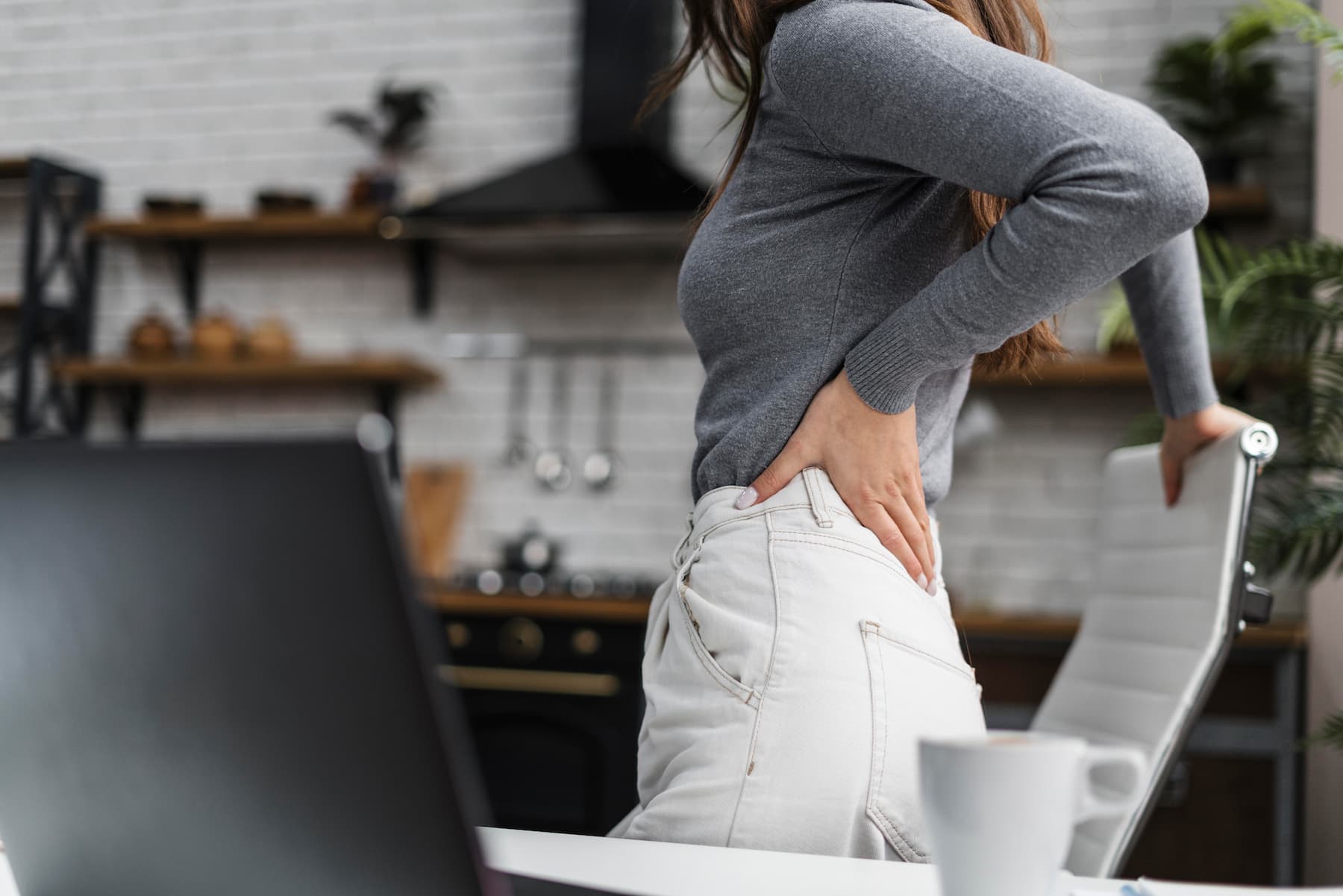
See why hip joints hurt and how to treat their ailments.
